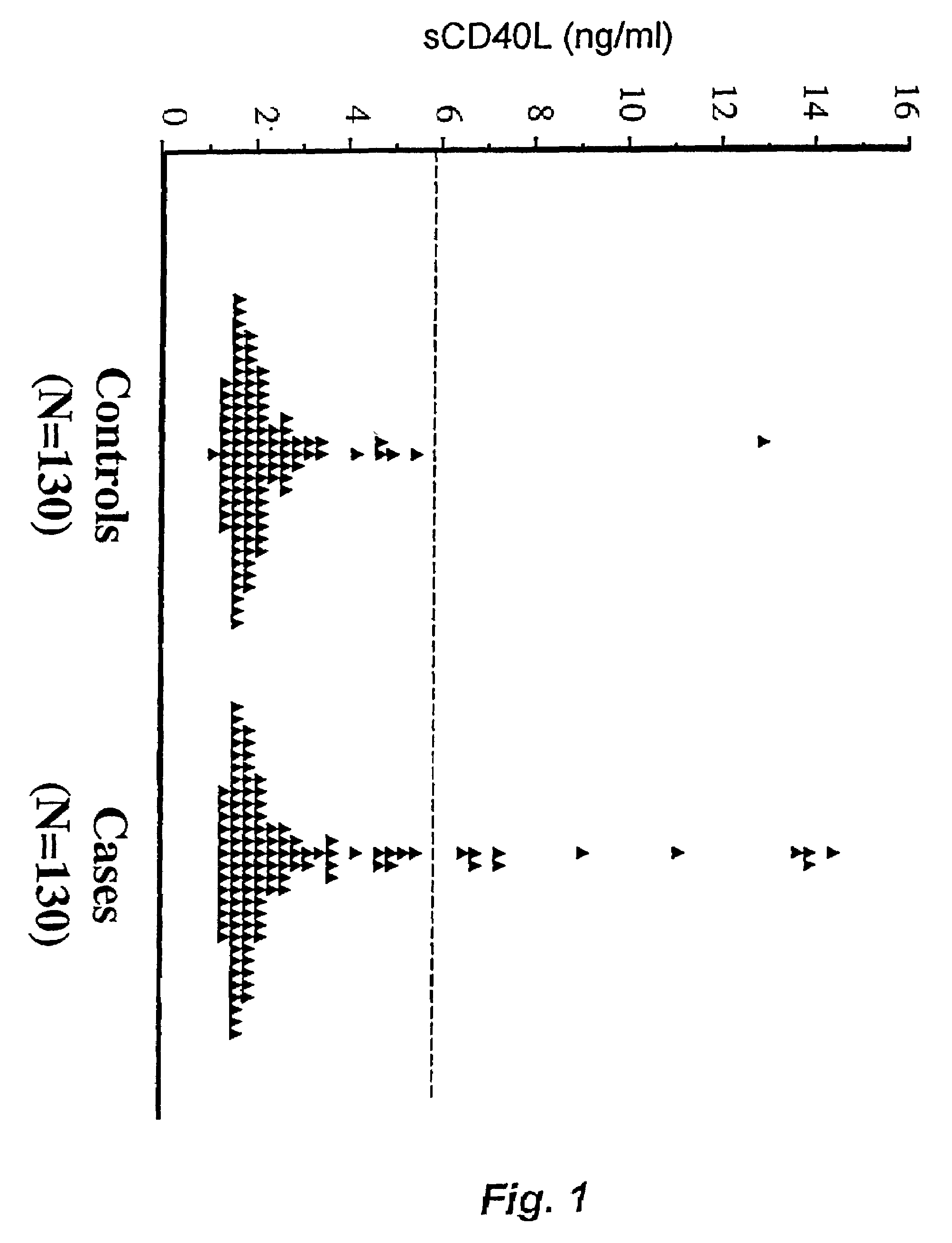Soluble CD40L(CD154) as a prognostic marker of atherosclerotic diseases
a prognostic marker and atherosclerosis technology, applied in the field of soluble cd40l, can solve the problem of predicting an increased risk of myocardial infarction, and achieve the effects of reducing the risk of the subject, preventing cardiovascular disorders, and limiting further injury
- Summary
- Abstract
- Description
- Claims
- Application Information
AI Technical Summary
Benefits of technology
Problems solved by technology
Method used
Image
Examples
example 1
REFERENCES INCORPORATED IN EXAMPLE 1
[0115]1. Alderson M R, Armitage R J, Tough T W, et al. J Exp Med. 1993;178:669–74.[0116]2. Reul R M, Fang J C, Denton M D, et al. Transplantation. 1997;64:1765–74.[0117]3. Mach F, Schönbeck U, Sukhova G K, et al. Proc Natl Acad Sci USA. 1997;94:1931–6.[0118]4. Henn V, Slupsky J R, Grafe M, et al. Nature. 1998;391:591–4.[0119]5. Schönbeck U, Libby P. Cell Mol Life Sci. 2001;58:4–43.[0120]6. Mach F, Schönbeck U, Sukhova G K, et al. Nature. 1998;394:200–3.[0121]7. Schönbeck U, Sukhova G K, Shimizu K, et al. Proc Natl Acad Sci USA. 2000;97:7458–63.[0122]8. Lutgens E, Cleutjens K B, Heeneman S, et al. Proc Natl Acad Sci USA. 2000;97:7464–9.[0123]9. Graf D, Muller S, Korthauer U, et al. Eur J Immunol. 1995;25:1749–54.[0124]10. Aukrust P, Muller F, Ueland T, et al. Circulation. 1999;100:614–20.[0125]11. Buring J E, Hennekens C H. J. Myocard. Ischemia. 1992;4:19–27.[0126]12. Ridker P M, Hennekens C H, Buring J E, et al. N Engl J Med. 2000;342:836–43.
DETAI...
example 2
REFERENCES INCORPORATED IN EXAMPLE 2
[0151]1. Libby P, Hansson G K. Lab. Invest. 1991;64:5–15.[0152]2. Ross R. N Engl J Med. 1999;340:115–126.[0153]3. Reul R M, Fang J C, Denton M D, et al. Transplantation. 1997;64:1765–1774.[0154]4. Mach F, Schönbeck U, Sukhova G K, et al. Proc Natl Acad Sci USA. 1997;94:1931–1936.[0155]5. Gaweco A S, Wiesner R H, Yong S, et al. Liver Transpl. Surg. 1999;5:1–7.[0156]6. Afford S C, Randhawa S, Eliopoulos A G, et al. J Exp Med 1999;189:441–446.[0157]7. Malik N, Greenfield B W, Wahl A F, et al. J Immunol. 1996;156:3952–3960.[0158]8. Zhou L, Stordeur P, de Lavareille A, et al. Thromb. Haemost. 1998;79:1025–1028.[0159]9. Miller D L, Yaron R, Yellin M J. J Leukoc Biol. 1998;63:373–379.[0160]10. Slupsky J R, Kalbas M, Willuweit A, et al. Thromb Haemost. 1998;80:1008–1014.[0161]11. Schönbeck U, Libby P. Cell Mol Life Sci. 2001;58:4–43.[0162]12. Schönbeck U, Libby P. Circ Res. 2001;89:1092–1103.[0163]13. Mach F, Schönbeck U, Sukhova G K, et al. Nature. 1998;...
example 3
REFERENCES INCORPORATED IN EXAMPLE 3
PUM
| Property | Measurement | Unit |
|---|---|---|
| concentrations | aaaaa | aaaaa |
| thickness | aaaaa | aaaaa |
| thickness | aaaaa | aaaaa |
Abstract
Description
Claims
Application Information
 Login to View More
Login to View More - R&D
- Intellectual Property
- Life Sciences
- Materials
- Tech Scout
- Unparalleled Data Quality
- Higher Quality Content
- 60% Fewer Hallucinations
Browse by: Latest US Patents, China's latest patents, Technical Efficacy Thesaurus, Application Domain, Technology Topic, Popular Technical Reports.
© 2025 PatSnap. All rights reserved.Legal|Privacy policy|Modern Slavery Act Transparency Statement|Sitemap|About US| Contact US: help@patsnap.com

